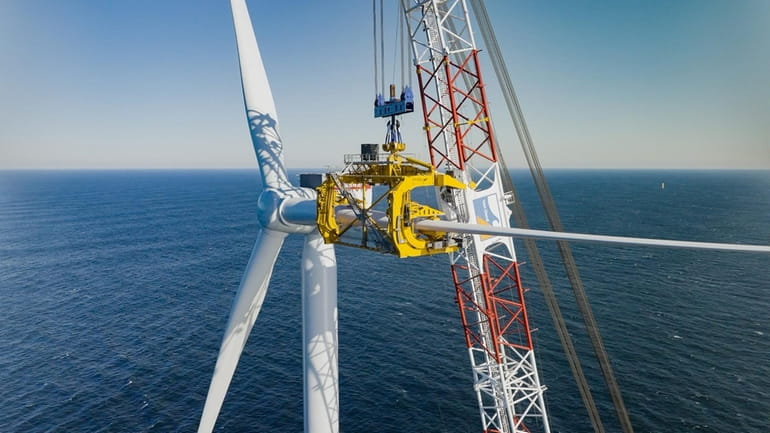South Fork Wind Farm starts sending power to LIPA electric grid

The final blade is attached to a turbine at the South Fork Wind Farm, one of 12 turbines that are to provide power to LIPA. Credit: Orsted
The $2.01 billion South Fork Wind Farm has begun sending some of its power to the Long Island grid, an early step in the state's plan for a carbon-free power grid in coming decades.
Denmark-based Orsted and New England utility Eversource announced last month the completion of the first of 12 turbines for the South Fork project in the waters off Rhode Island and Massachusetts. That turbine and another have been sending power to the LIPA grid at East Hampton since Nov. 30, officials said Wednesday.
The remaining 10 turbines under construction are each expected to begin sending power via a 68-mile cable connecting at Wainscott in the coming weeks. The turbines, not visible from Long Island, are about 800 feet tall and capable of producing up to 11 megawatts of power each. The array, when completed early next year, will supply enough power for about 70,000 homes, officials said.
State, local and industry officials in East Hampton on Wednesday marked the milestone, which has been more than six years in the making since the LIPA board of trustees approved the project in January 2017. It's the first utility-scale offshore wind farm in federal waters, and the first of about 9,000-plus megawatts of offshore wind planned for New York State.
The array is expected to cost average LIPA customers around $1.35 a month, according to LIPA, though bigger power users will see a greater impact, and the cost will escalate marginally each year over the 25-year life of the contract. The project has an estimated cost of $2,013,198,056, according to the state comptroller's website.
Most of the energy will go to the power-hungry South Fork, chiefly in the Hamptons, where power usage has been increasing in recent years.
Word of the successful production of power from the South Fork project marked a positive development for the offshore industry in the United States after months of troubling news from mostly European developers who have set large ambitions for the nascent U.S. market. To date, the largest offshore wind farm is the Block Island array of five smaller turbines in state waters.
David Hardy, chief executive of Orsted's Americas region, called Wednesday's announcement a "huge milestone" that took "immense effort, commitment and perseverance." Critics of the project, including commercial fishermen and a well-funded group of residents who opposed the cable landing site in Wainscott, were plentiful. Hardy credited East Hampton Town officials, among others, for helping push the project through.
"We're standing at an important moment in time," said Hardy, who noted the powering up of South Fork showed "offshore wind is viable."
Orsted itself has been battered by setbacks tied to the soaring cost of materials to build wind arrays and soaring interest rates to finance them. Last month, Orsted's Denmark parent canceled two projects planned for the New Jersey coast, a decision that led to more than $4 billion in impairment charges and caused its stock price to plummet. Its U.S. partner Eversource has said it plans to completely divest its interest in offshore wind.
Nevertheless, the companies plan to rebid the Sunrise Wind farm project planned for Long Island early next year, which is expected to bring about 924 megawatts of power to the region.
"While we review the [Sunrise Wind] request for proposals and determine our next steps, we know that ready-to-build projects like Sunrise Wind are the only offshore wind farms that can be delivered within the next several years, a timeline that would be critical to meeting the state’s ... clean energy targets," Orsted and Eversource said in a statement.
Doreen Harris, chief executive of the New York State Energy Research and Development Authority, which is leading the state's efforts in green energy, including administering offshore wind solicitations, said the 9,000 megawatts of offshore wind planned for the state by 2035 may be "just the beginning."
LIPA chief Tom Falcone told the East Hampton gathering there's a "whole new [energy infrastructure] coming," led by offshore wind but also including more solar energy and battery storage. By 2030, LIPA will be getting half its power from offshore wind, he said, adding: "We're going to build a lot more" offshore wind.
Commercial fishing groups have opposed the South Fork project, some calling for compensation for lost fishing grounds that other states have negotiated.
Energy from South Fork Wind won't be stored initially in a large battery unit that was built at the East Hampton substation. That battery had a fire in May and is expected to be out of commission until June 2024, officials have said. The battery, undergoing spill remediation and replacement, sits adjacent to a new offshore wind receiver station in East Hampton.
"It's never easy to be first," said Assemb. Fred Thiele (D-Sag Harbor), who called it "no accident" that the first offshore wind power landed in East Hampton, "which has always been a leader."
Judith Hope, a former town supervisor who co-founded the advocacy group Win With Wind, noted there was "intense political pressure exerted on the governor" to stop the project, but Gov. Kathy Hochul didn't bend to it. "The opposition was well connected and extremely well funded," she said.
Hochul, in a statement, noted that in addition to new jobs and clean power, South Fork Wind will "demonstrate to all that offshore wind is a viable resource New York can harness for generations to come."
The $2.01 billion South Fork Wind Farm has begun sending some of its power to the Long Island grid, an early step in the state's plan for a carbon-free power grid in coming decades.
Denmark-based Orsted and New England utility Eversource announced last month the completion of the first of 12 turbines for the South Fork project in the waters off Rhode Island and Massachusetts. That turbine and another have been sending power to the LIPA grid at East Hampton since Nov. 30, officials said Wednesday.
The remaining 10 turbines under construction are each expected to begin sending power via a 68-mile cable connecting at Wainscott in the coming weeks. The turbines, not visible from Long Island, are about 800 feet tall and capable of producing up to 11 megawatts of power each. The array, when completed early next year, will supply enough power for about 70,000 homes, officials said.
State, local and industry officials in East Hampton on Wednesday marked the milestone, which has been more than six years in the making since the LIPA board of trustees approved the project in January 2017. It's the first utility-scale offshore wind farm in federal waters, and the first of about 9,000-plus megawatts of offshore wind planned for New York State.
WHAT TO KNOW
- The $2.01 billion South Fork Wind Farm has begun sending some of its power from two turbines to the Long Island electric grid.
- The remaining 10 turbines under construction are each expected to begin sending power via a 68-mile cable connecting at Wainscott in the coming weeks.
- The turbines are about 800 feet tall and capable of producing up to 11 megawatts of power each. The array, when completed early next year, will supply enough power for about 70,000 homes, officials said.
The array is expected to cost average LIPA customers around $1.35 a month, according to LIPA, though bigger power users will see a greater impact, and the cost will escalate marginally each year over the 25-year life of the contract. The project has an estimated cost of $2,013,198,056, according to the state comptroller's website.
Most of the energy will go to the power-hungry South Fork, chiefly in the Hamptons, where power usage has been increasing in recent years.
Word of the successful production of power from the South Fork project marked a positive development for the offshore industry in the United States after months of troubling news from mostly European developers who have set large ambitions for the nascent U.S. market. To date, the largest offshore wind farm is the Block Island array of five smaller turbines in state waters.
David Hardy, chief executive of Orsted's Americas region, called Wednesday's announcement a "huge milestone" that took "immense effort, commitment and perseverance." Critics of the project, including commercial fishermen and a well-funded group of residents who opposed the cable landing site in Wainscott, were plentiful. Hardy credited East Hampton Town officials, among others, for helping push the project through.
"We're standing at an important moment in time," said Hardy, who noted the powering up of South Fork showed "offshore wind is viable."
Orsted itself has been battered by setbacks tied to the soaring cost of materials to build wind arrays and soaring interest rates to finance them. Last month, Orsted's Denmark parent canceled two projects planned for the New Jersey coast, a decision that led to more than $4 billion in impairment charges and caused its stock price to plummet. Its U.S. partner Eversource has said it plans to completely divest its interest in offshore wind.
Nevertheless, the companies plan to rebid the Sunrise Wind farm project planned for Long Island early next year, which is expected to bring about 924 megawatts of power to the region.
"While we review the [Sunrise Wind] request for proposals and determine our next steps, we know that ready-to-build projects like Sunrise Wind are the only offshore wind farms that can be delivered within the next several years, a timeline that would be critical to meeting the state’s ... clean energy targets," Orsted and Eversource said in a statement.
Doreen Harris, chief executive of the New York State Energy Research and Development Authority, which is leading the state's efforts in green energy, including administering offshore wind solicitations, said the 9,000 megawatts of offshore wind planned for the state by 2035 may be "just the beginning."
LIPA chief Tom Falcone told the East Hampton gathering there's a "whole new [energy infrastructure] coming," led by offshore wind but also including more solar energy and battery storage. By 2030, LIPA will be getting half its power from offshore wind, he said, adding: "We're going to build a lot more" offshore wind.
Commercial fishing groups have opposed the South Fork project, some calling for compensation for lost fishing grounds that other states have negotiated.
Energy from South Fork Wind won't be stored initially in a large battery unit that was built at the East Hampton substation. That battery had a fire in May and is expected to be out of commission until June 2024, officials have said. The battery, undergoing spill remediation and replacement, sits adjacent to a new offshore wind receiver station in East Hampton.
"It's never easy to be first," said Assemb. Fred Thiele (D-Sag Harbor), who called it "no accident" that the first offshore wind power landed in East Hampton, "which has always been a leader."
Judith Hope, a former town supervisor who co-founded the advocacy group Win With Wind, noted there was "intense political pressure exerted on the governor" to stop the project, but Gov. Kathy Hochul didn't bend to it. "The opposition was well connected and extremely well funded," she said.
Hochul, in a statement, noted that in addition to new jobs and clean power, South Fork Wind will "demonstrate to all that offshore wind is a viable resource New York can harness for generations to come."

